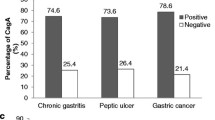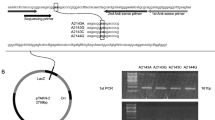Abstract
We have previously reported a high prevalence of H. pylori DNA in saliva. In this study, the cytotoxin genotypes of H. pylori strains from both stomach and saliva were compared in 31 patients with gastritis and peptic ulcer. The cagA, vacA m1, vacA m2, and vacA s1 genotypes were analyzed by PCR. The 417 bp PCR products from three patients were also subjected to DNA sequencing analysis. There was 95% agreement between stomach H. pylori isolates and their corresponding saliva DNA in at least one cytotoxin genotype; 86% agreement with two cytotoxin genotypes; 59% agreement with three cytotoxin genotypes; and 27% agreement with all four cytotoxin genotypes studied. DNA sequencing from three patients showed 78.0%, 64.0%, and 66.9% homology of H. pylori from both sources, respectively. The data suggest that more than one H. pylori strain may exist in the stomach and saliva in the same patient.
Similar content being viewed by others
REFERENCES
Li C, Musich PR, Ha T, Ferguson DA Jr, Patel NR, Chi DS, Thomas E: High prevalence of Helicobacter pylori in saliva demonstrated by a novel PCR assay. J Clin Pathol 48:662–666, 1995
Li C, Ha T, Ferguson DA Jr, Chi DS, Zhao R, Patel NR, Krishnaswamy G, Thomas E: A newly developed PCR assay of H. pylori in gastric biopsy, saliva, and feces. Evidence of high prevalence of H. pylori in saliva supports oral transmission. Dig Dis Sci 41:2142–2149, 1996
Lakatos PL, Lakatos L, Papp J: Pathophysiology of Helicobacter pylori infection. Orv Hetil 140:1723–1730, 1999
Alarcon T, Martinez MJ, Urruzuno P, Cilleruelo ML, Madruga D, Sebastian M, Domingo D, Sanz JC, Lopez-Brea M: Prevalence of cagA and vacA antibodies in children with Helicobacter pylori-associated peptic ulcer compared to prevalence in pediatric patients with active or nonactive chronic gastritis. Clin Dia Lab Immunol 7:842–844, 2000
Martin Guerrero JM, Hergueta Delgado P, Esteban Carretero J, Romero Castro R, Pellicer Bautista FJ, Herrerias Gutierrez JM: Clinical relevance of Helicobacter pylori cagA-positive strains: gastroduodenal peptic lesions marker. Rev Esp Enferm Dig 92:160–173, 2000
Lin CW, Wu SC, Lee SC, Cheng KS: Genetic analysis and clinical evaluation of vacuolation cytotoxin gene A and cytotoxin-associated gene A in Taiwanese Helicobacter pylori isolates from peptic ulcer patients. Scand J Infect Dis 32:51–57, 2000
Ferguson DA Jr, Li C, Patel NR, Mayberry WR, Chi DS, Thomas E: Isolation of Helicobacter pylori from saliva. J Clin Microbiol 31:2802–2804, 1993
Li C, Ferguson DA Jr, Ha T, Chi DS, Thomas E: A highly specific and sensitive DNA probe derived from chromosomal DNA of Helicobacter pylori is useful for typing H. pylori isolates. J Clin Microbiol 31:2157–2162, 1993
Atherton JC, Cao P, Peek Jr. RM, Tummuru MR, Blaser MJ, Cover TL: Mosaicism in vacuolating cytotoxin alleles of Helicobacter pylori. J Biol Chem 270:17771–17777, 1995
Riggio MP, Lennon A: Identification by PCR of Helicobacter pylori in subgingival plaque of adult periodontitis patients. J Med Microbiol 48:317–322, 1999
Oshowo A, Gillam D, Botha A, Tunio M, Holton J, Boulos P, Hobsley M: Helicobacter pylori: The mouth, stomach, and gut axis. Ann Periodontol 3:276–280, 1998
Pytko-Polonczyk J, Konturek SJ., Karczewska E, Bielanski W, Kaczmarczyk-Stachowska A: Oral cavity as permanent reservoir of Helicobacter pylori and potential source of reinfection. A Physiol Pharmacol 47:121–129, 1996
Gzyl A, Berg DE, Dzierzanowska D: Epidemiology of cagA/vacA genes in H. pylori isolates from children and adults in Poland. J Physiol Pharmacol 48:333–343, 1997
Warburton VJ, Everett S, Mapstone NP, Axon AT, Hawkey P, Dixon MF: Clinical and histological associations of cagA and vacA genotypes in Helicobacter pylori gastritis. J Clin Pathol 51:55–61, 1998
van Doorn L-J, Schneeberger PM, Nouhan N, Plaisier AP, Quint WGV, de Boer WA: Importance of Helicobacter pylori cagA and vacA status for the efficacy of antibiotic treatment. Gut 46:321–326, 2000
Mahachai V, Tangkijvanich P, Wannachai N, Sumpathanukul P, Kullavanijaya P: CagA and vacA: Virulence factors of Helicobacter pylori in Thai patients with gastrocuodenal diseases. Helicobacter 4:143–147, 1999
Strobel S, Bereswill S, Balig P, Allgaier P, Sonntag H-G, Kist M: Identification and analysis of a new vacA genotype variant of Helicobacter pylori in different patient groups in Germany. J Clin Microbiol 36:1285–1289, 1998
Lamarque D, Gilbert T, Roudot-Thoraval F, Deforges L, Chaumette MT, Delchier JC: Seroprevalence of eight Helicobacter pylori antigens among 182 patients with peptic ulcer, MALT gastric lymphoma of non-ulcer dyspepsia. Higher rate of seroreactivity against cagA and 35-kDa antigens in patients with peptic ulcer originating from Europe and Africa. Eur J Gastroenterol Hepatol 11:721–726, 1999
Beil W, Enss ML, Muller S, Obst B, Sewing K-F, Wagner S: Role of vacA and cagA in Helicobacter pylori inhibition of mucin synthesis in gastric mucous cells. J Clin Microbiol. 38:2215–2218, 2000
Zhang Y, Lu X: Detection and differentiation of Helicobacter pylori from gastric biopsy and saliva by PCR-SSCP. Chung Hua Nei Ko Tsa Chih 36:446–449, 1997
Khandaker K, Palmer KR, Eastwood MA, Scott AC, Desai M, Owen RJ: DNA fingerprints of Helicobacter pylori from mouth and antrum of patients with chronic ulcer dyspepsia. Lancet 342:751, 1993
Shames B, Krajden S, Fuksa M, Babida C, Penner JL: Evidence for the occurrence of the same strain of Campylobacter pylori in the stomach and dental plaque. J Clin Microbiol 27:2849–2850, 1989
Ge Z, Taylor DE: Contributions of genome sequencing to understanding the biology of Helicobacter pylori. Annu Rev Microbiol 53:353–387, 1999
Alm RA, Ling LS, Moir DT, King BL, Brown ED, Doig PC, Smith DR, Noonan B, Guild BC, deJonge BL, Carmel G, Tummino PJ, Caruso A, Uria-Nickelsen M, Mills DM, Ives C, Gibson R, Merberg D, Mills SD, Jiang Q, Taylor DE, Vovis GF, Trust TJ: Genomic-sequence comparison of two unrelated isolates of the human gastric pathogen Helicobacter pylori. Nature 397:176–180, 1999
Alm RA, Trust TJ: Analysis of the genetic diversity of Helicobacter pylori: the tale of two genomes. J Mol Med 77:834–846, 1999
Li C, Ha T, Chi DS, Ferguson DA Jr, Jiang C, Laffan JJ, Thomas E: Differentiation of Helicobacter pylori strains directly from gastric biopsy specimens by PCR-based restriction fragment length polymorphism analysis without culture. J Clin Microbiol 35:3021–3025, 1997
Jiang C, Li C, Chi DS, Ferguson DA Jr, Ha T, Laffan JJ, Thomas E: Combination of single-and double-stranded conformational polymorphism for direct discrimination of gastric Helicobacter pylori. J Microbiol Metheds 34:1–8, 1998
Blaser MJ: Heterogeneity of Helicobacter pylori. Eur J Gastroenterol Hepatol. 9:S3–S7, 1997
Occhialini A, Urdaci M, Doucet-Populaire F, Bebear CM, Lamouliatte H, Megraud F: Macrolide resistance in Helicobacter pylori: Rapid detection of point mutations and assays of macrolide binding to ribosomes. Antimicrob Agents Chemother 41:2724–2728, 1997
Stone GG, Shortridge D, Flamm RK, Versalovic J, Beyer J, Idler K, Zulawinski L, Tanaka SK: Identification of a 23SrRNA gene mutation in clarithromycin-resistant Helicobacter pylori. Helicobacter 1:227–228, 1996
Ge Z, Taylor DE: Rapid polymerase chain reaction screening of Helicobacter pylori chromosomal point mutations. Helicobacter 2:127–131, 1997
Tanahashi T, Kita M, Kodama T, Sawai N, Yamaoka Y, Mitsufuji S, Katoh F, Imanishi J: Comparison of PCRrestriction fragment length polymorphism analysis and PCRdirect sequencing methods for differentiating Helicobacter pylori ureB gene variants. J Clin Microbiol 38:165–169, 2000
Enroth H, Bjorkholm B, Engstrand L: Occurrence of resistance mutation and clonal expansion in Helicobacter pylori multiple-strain infection: A potential risk in clarithromycinbased therapy. Clin Infect Dis 28:1305–1307, 1999
Author information
Authors and Affiliations
Rights and permissions
About this article
Cite this article
Wang, J., Chi, D.S., Laffan, J.J. et al. Comparison of Cytotoxin Genotypes of Helicobacter pylori in Stomach and Saliva. Dig Dis Sci 47, 1850–1856 (2002). https://doi.org/10.1023/A:1016417200611
Issue Date:
DOI: https://doi.org/10.1023/A:1016417200611




